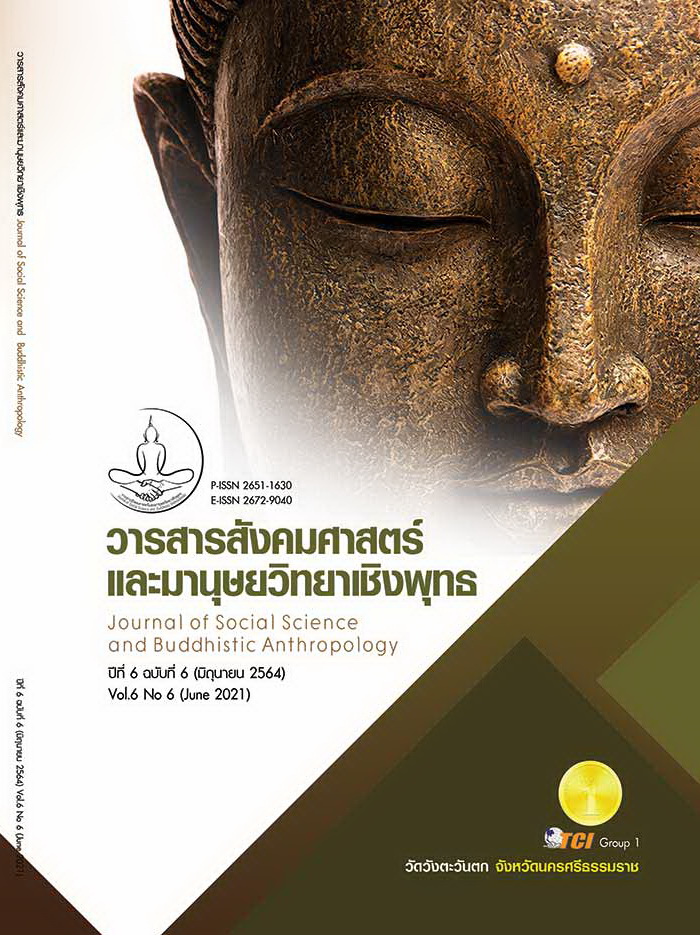MARKET DEMAND AND CAPACITY OF WELLNESS TOURISM IN NAKHON SI THAMMARAT PROVINCE
Keywords:
Market Demand, Capacity of Wellness Tourism in Nakhon Si Thammarat, Business Cluster, Nakhon Si ThammaratAbstract
The objectives of this research article were to 1) Study the need of wellness tourist in Nakhon Si Thammarat Province 2) Evaluate the potential of wellness tourism in Nakhon Si Thammarat Province. and 3) Explore wellness tourism business cluster in Nakhon Si Thammarat Province. Mixed Methodology were applied in this study. The researcher collected qualitative data from 30 stakeholders in the business cluster and quantified data from 400 tourists in Nakhon Si Thammarat Province. The quantitative data was analyzed using frequency, percentage, standard deviation, t - test and F - test. The qualitative data were analyzed with content analysis. The results show that 1) most of the tourists traveling to Nakhon Si Thammarat were teenagers and early working age groups. They travel with their families for recreation and nature as their primary objective and use wellness services along the way. Travelers have moderate need toward healthcare service and spiritual-care service, but high need toward mind - care service. The service that tourists want to receive the most is healthy food. 2) Nakhon Si Thammarat Province has high potential in spa, Thai massage, fitness, health food, and traditional Thai medicine, while has low potential in sports and advantage activities services. 3) Nakhon Si Thammarat wellness tourism cluster divided into 4 groups: 1) tourism industry, 2) supported industry, 3) government agencies/association and 4) health-service industry. The first three groups are industrial groups with high potential and effective business cooperation. However, the healthcare industry has such moderate potential and no formal business cooperation.
References
คมสิทธิ์ เกียนวัฒนา และคณะ. (2561). สถานการณ์ความต้องการและแนวโน้มของรูปแบบการท่องเที่ยวเชิงสุขภาพในประเทศไทย. วารสารวิชาการสถาบันการพลศึกษา, 10(1), 167-177.
นัทธ์หทัย เถาตระกูล และภัทรพรรณ วรรณลักษณ์. (2563). การตัดสินใจท่องเที่ยวของนักท่องเที่ยวชาวไทยในแหล่งท่องเที่ยวเชิงสุขภาพในจังหวัดเชียงใหม่. วารสารมหาวิทยาลัยคริสเตียน, 26(2), 72-83.
ใบเฟิร์น วงษ์บัวงาม และมุขสุดา พูลสวัสดิ์. (2556). การประเมินศักยภาพแหล่งท่องเที่ยวเชิงเกษตร โครงการที่ได้รับรางวัลจากการประกวดผลงานตามปรัชญาของเศรษฐกิจพอเพียงภาคการเกษตร ในเขตกรุงเทพและปริมณฑล. กรุงเทพมหานคร: มหาวิทยาลัยเทคโนโลยีราชมงคลพระนคร.
แพรดาว ฟูพาณิชย์พฤกษ์. (2561). การศึกษาการดำเนินนโยบายท่องเที่ยวตามแผนพัฒนาการท่องเที่ยวแห่งชาติ พ.ศ.2555-2559 ของคลัสเตอร์ท่องเที่ยวกลุ่ม Active Beach. วารสารรัฐประศาสนศาสตร์, 14(1). 45-63.
ราณี อิสิชัยกุล. (2560). การท่องเที่ยวเชิงสุขภาพ. การจัดการการท่องเที่ยวเฉพาะทาง (Niche tourism management). (pp 17-20). นนทบุรี: มหาวิทยาลัยสุโขทัยธรรมาธิราช.
ศันสนีย์ กระจ่างโฉม และกรวรรณ สังขกร. (2563). พฤติกรรมและความต้องการของนักท่องเที่ยวเพื่อสุขภาพชาวไทยและชาวต่างชาติในภาคเหนือตอนบน. วารสารวิชาการมหาวิทยาลัยหอการค้าไทย มนุษยศาสตร์และสังคมศาสตร์, 40(1), 57-76.
ศิริพงษ์ ศรีไสไพร และคณะ. (2560). ความต้องการของตลาดและศักยภาพในการรองรับการท่องเที่ยวเชิงสุขภาพของประเทศไทย. ใน รายงานสืบเนื่องการประชุมวิชาการระดับชาติครั้งที่ 12 เรื่อง Health and Wellness: สุขภาพและความสุขสบาย วันที่ 3 มีนาคม 2560. 591-605. มหาวิทยาลัยธุรกิจบัณฑิตย์.
สิทธา กองสาสนะ. (2552). การศึกษาเส้นทางท่องเที่ยวเชิงสุขภาพในจังหวัดขอนแก่น. วารสารวิทยาการจัดการ มหาวิทยาลัยราชภัฏเชียงราย, 4(2), 35-58.
Csapó, J. & Marton, G. (2017). The Role and Importance of Spa and Wellness Tourism in Hungary’s Tourism Industry. Czech Journal of Tourism, 6(1), 55–68.
Porter, M. E. (1998). Clusters and the new economics of competition. Harvard Business Review, 76(6), 77–90.
The Global Spa Summitt & SRI International. (2010). The Wellness Consumer. Global Spa Summit, Spas and the Global Wellness Market: Synergies and Opportunities. In prepared by SRI International, May 2010 (pp. 25-32). Florida: GSS.
The Global Wellness Institute. (2014). Types of Wellness Tourism. The Global Wellness Tourism Economy Report 2013 & 2014. In Global Spa & Wellness Economy Monitor (pp. 39-40). Miami: GWI.
The Global Wellness Institute. (2017). What is included in wellness tourism? In Global Wellness Economy Monitor January 2017 (pp. 18-19). Miami: GWI.
The Global Wellness Institute. (2018). Executive Summary. In The Global Wellness Economy. Global Wellness Economy Monitor October 2018 (pp. 3-10). Miami: GWI.








